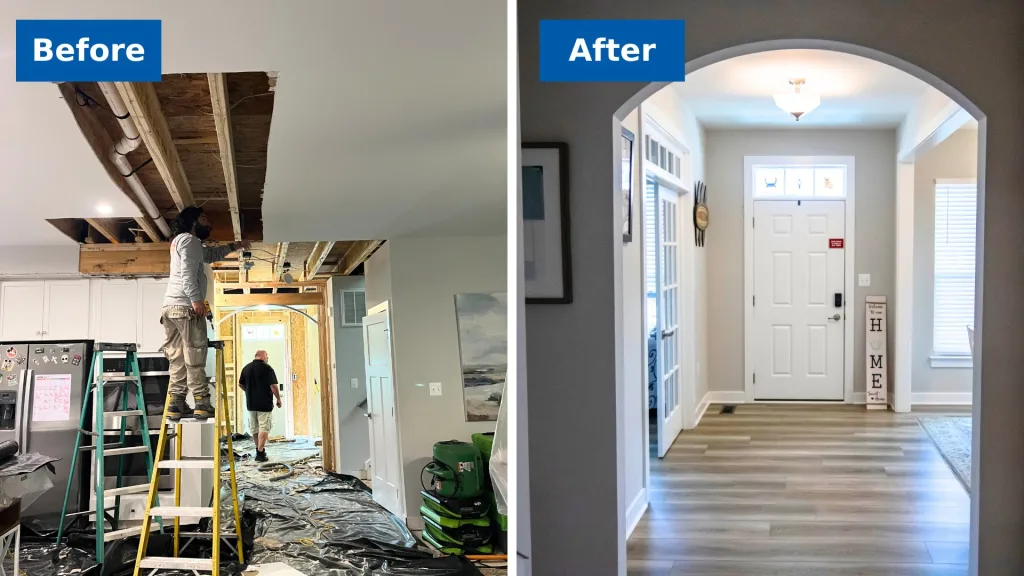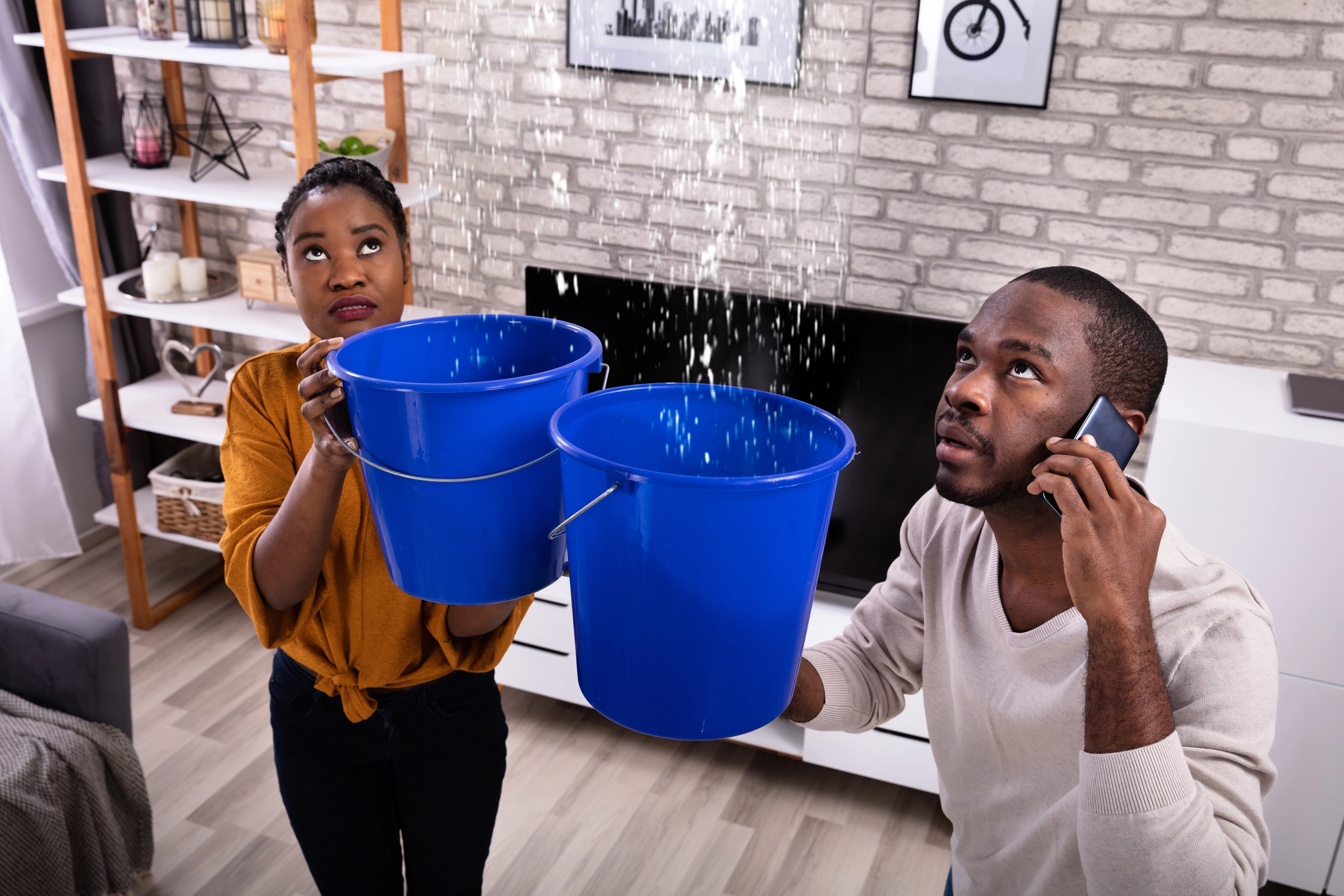Essential Steps to Adhere To for Reliable Water Damages Reconstruction in Your Home
When faced with water damage in your house, recognizing the crucial steps for effective restoration can make all the distinction. You require to evaluate the damage and guarantee safety and security prior to dealing with the issue. Stopping the source of water is vital, but it's simply the beginning. There's a collection of actions you must take to secure your property from further issues as soon as you have actually managed that. Allow's explore what you need to do following.
Assess the Damage
When you uncover water damage in your house, the very first step is to analyze the damage completely. Beginning by identifying the resource of the water breach. Look for leaks, ruptured pipelines, or other issues triggering the trouble. Next off, analyze the impacted locations for noticeable signs of damage, consisting of mold and mildew, bending, or staining development. Don't fail to remember to look in surprise spots like behind walls or under flooring, as water can seep into these locations unnoticed.Document the damages by taking clear pictures and notes. When going over the scenario with your insurance provider or remediation professionals, this will help you. Focus on the type of materials affected, as different products call for various reconstruction strategies. Examine the degree of the damage. Is it minor or comprehensive? Understanding the extent will certainly guide you in determining whether to manage it on your own or employ the professionals for a much more comprehensive remediation procedure.

Guarantee Safety and security
Prior to you begin any remediation work, ensuring your safety and security is essential. First, evaluate the problem of your home. If the water's deep or if you notice electrical threats, don't enter the location. Switch off the electrical energy and gas supply to protect against accidents. Wear safety gear like gloves, masks, and boots to shield yourself from impurities or mold.It's essential to remain knowledgeable about your surroundings; expect unsafe surface areas and sharp things. If the water is from a sewage backup, treat it as unsafe waste. Keep children and pets far from impacted areas to avoid exposure.Once you have actually taken these preventative measures, you can wage the reconstruction procedure. Keep in mind, your safety comes initially, and if you're ever before uncertain, it's best to consult a specialist. Taking these actions will aid ensure you prepare to tackle the reconstruction safely and effectively.
Stop the Resource of Water
After ensuring your safety and security, the next action is to quit the source of water. Recognize where the leak is coming from. Maybe a burst pipeline, a malfunctioning device, or also heavy rain entering via a damaged roof. If it's a pipes issue, switch off the main water to your home to stop further flooding. For home appliances, unplug them and turn off their water supply valves.If the resource is outdoors, like rainwater, attempt to divert it away from your home making use of sandbags or other obstacles. For minor leakages, you could be able to use tape or a sealer temporarily up until a specialist can fix it. Bear in mind, dealing with the resource quickly is essential to lessening damages and avoiding mold and mildew growth. When you have actually stopped the water, you'll remain in a better setting to carry on to the next action in the repair process.

Get Rid Of Excess Water
Act swiftly to eliminate excess water, as standing water can lead to extra extensive damage and mold development. Initially, gather your tools: a wet/dry vacuum cleaner, containers, and towels. If the water is superficial, you can use towels to take in the moisture. For deeper water, a wet/dry vacuum is your ideal bet. Ensure to empty the vacuum cleaner often to avoid overflow.If the water is polluted, like from a sewer backup, put on protective equipment, including handwear covers and masks, to keep on your own risk-free. As soon as you've eliminated as much water as possible, look for surprise pockets of wetness in edges and under furniture, as these can harbor mold.Don' t neglect to switch off electric appliances and power electrical outlets in wet areas to stop risks. This preliminary action is necessary in lessening damages and setting the phase for a successful restoration process.
Dry and Dehumidify the Area
It's important to completely dry and evaporate the area completely as soon as you have actually removed the excess water. Begin by utilizing dehumidifiers effectively to pull wetness out of the air and prevent mold development. Keep an eye on moisture degrees to assure the area dries out totally.
Get Rid Of Standing Water
To properly tackle water damages, you require to focus on eliminating standing water as swiftly as feasible. Start by gathering needed devices, like a wet/dry vacuum cleaner or a pump, depending upon the volume of water. If the water is shallow, a vacuum cleaner ought to suffice. For larger quantities, a pump is more effective. While working, see to it to wear protective equipment to maintain on your own risk-free from pollutants. As you remove the water, pay attention to hidden locations like under furnishings or in corners where water may collect. Once you have actually removed the click here bulk, your area will start to dry. This step is necessary, as remaining water can result in mold development and a lot more substantial damage.
Use Dehumidifiers Properly
Exactly how can you efficiently make use of dehumidifiers to completely dry and dehumidify your room? Begin by placing your dehumidifier in one of the most afflicted area, preferably where water damage is most extreme. Make certain to close all doors and windows to develop a closed environment. Switch on the dehumidifier and set it to the ideal humidity degree, generally around 30-50%. Empty the water collection tank regularly, or think about using a version with a continual drain option for comfort. Preferably, make use of fans to enhance air flow, aiding the dehumidifier work extra effectively. Maintain the dehumidifier running until you're certain that the area is completely dried, avoiding mold and mildew development and additional damage (Smoke Damage Restoration). This step is vital for effective water damages remediation
Monitor Humidity Levels
Tracking moisture levels is essential during the drying out procedure, as it aids ensure your space remains devoid of excess moisture. Invest in a trusted hygrometer to track humidity accurately. Ideally, you desire to keep degrees between 30% and 50%. If humidity readings increase over this array, you might require to adjust your dehumidifiers or fans to improve air flow. Inspect the analyses consistently, especially in areas prone to dampness, like basements or restrooms. If you discover consistent high humidity, think about boosting air flow or utilizing extra dehumidifiers. Remaining on top of these degrees not just speeds up the drying process yet additionally avoids mold growth, guaranteeing your home stays comfortable and risk-free.
Clean and Disinfect Affected Surfaces

Restore and Fix Your Home
After cleansing and decontaminating the influenced locations, it's time to bring back and repair your home. Begin by examining the damage. Look for structural issues, like compromised walls or floors, and resolve any kind of needed repair services. Replacing damaged drywall or floor covering is essential for both looks and safety.If your furniture or valuables were impacted, take into consideration whether they can be recovered or require substitute. Tidy or skillfully recover products where possible.Next, touch and repaint wall surfaces up any type of locations that require attention. This not only boosts look but likewise shields surfaces from future water damage.Don' t fail to remember to examine your pipes and appliances for leaks, making sure every little thing's functioning appropriately. Ultimately, consider installing a dehumidifier to stop future dampness concerns. By taking these steps, you'll restore your home to its former magnificence and produce a more secure living setting.
Regularly Asked Inquiries
The Length Of Time Does Water Damage Repair Generally Take?
Water damages reconstruction generally takes anywhere from a few days to numerous weeks, relying on the degree of the damages (Water Damage Restoration St George UT). You'll want to examine the scenario quickly to reduce more problems and ensure appropriate reconstruction
Will My Insurance Coverage Cover Water Damages Restoration Prices?
Your insurance coverage could cover water damage restoration prices, but it depends on your policy. Inspect your coverage details and call your insurance policy agent to clarify what's included and what you require to sue.
Can I Manage Water Damages Reconstruction Myself?
You can deal with water damages reconstruction yourself, yet it's vital to evaluate the circumstance first. You may want to call experts if it's extensive. Always prioritize safety and guarantee you have actually obtained the right tools.
What Are the Signs of Hidden Water Damages?
You may notice indicators of surprise water damage like warped wall surfaces, moldy odors, or staining. If your floors really feel mushy or you spot mold and mildew, it's time to examine further prior to the circumstance worsens.
Just How Can I Avoid Future Water Damages in My Home?
To stop future water damages in your home, you ought to regularly check pipes, seal cracks, keep gutters, and assurance correct drainage. Setting up a sump pump and dampness obstacles can likewise aid keep your space completely dry. When you uncover water damage in your home, the very first action is to assess the damage extensively. Act quickly to eliminate excess water, as standing water can lead to a lot more extensive damage and mold and mildew development. To efficiently take on water damages, you need to focus on getting rid of standing water as promptly as possible. As you eliminate the water, pay focus to concealed areas like under furnishings or in edges where water could gather. Water damages repair typically takes anywhere from a couple of days to a number of weeks, depending on the degree of the damages.